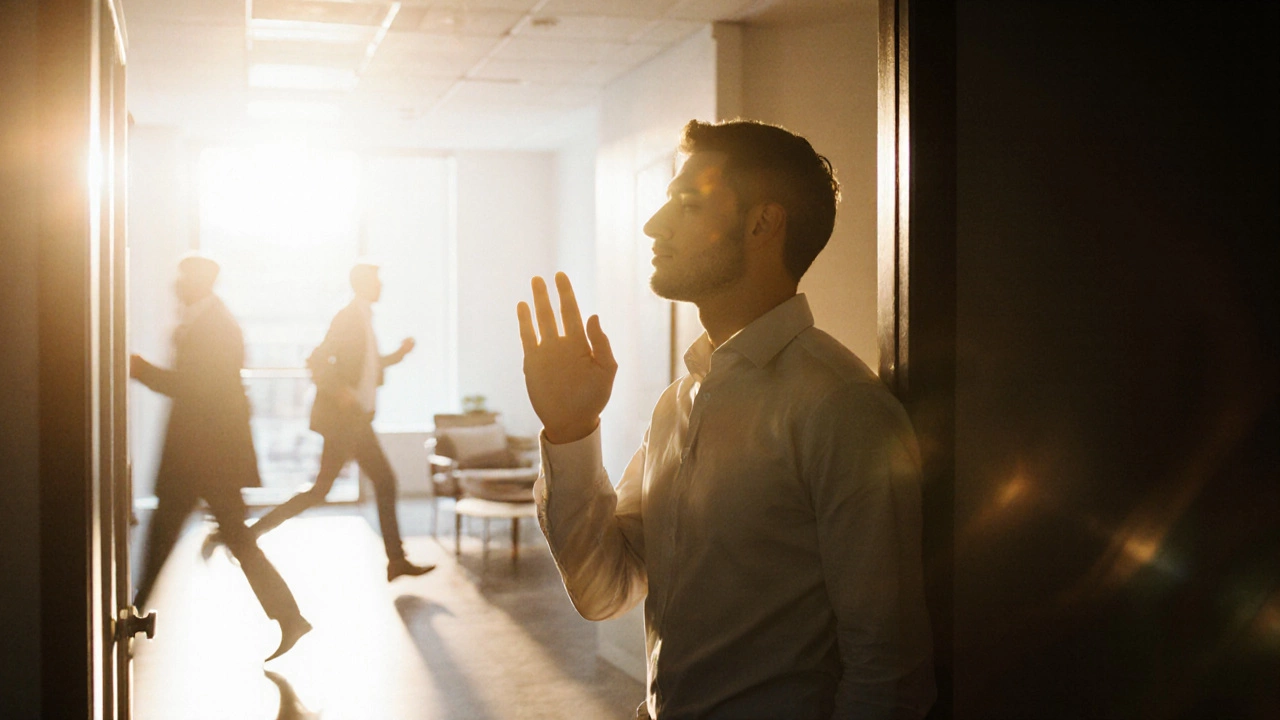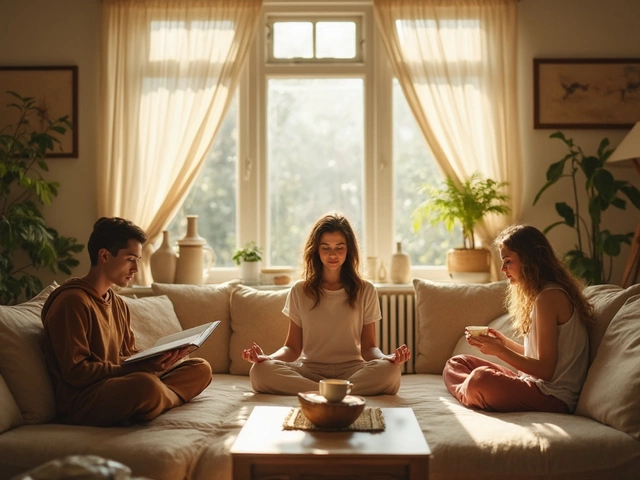Mindfulness Trigger Generator
Your Mindfulness Routine
Turn daily actions into mindfulness anchors using the article's 'triggers' method. Enter your routines below.
Add Your Daily Trigger
1. Choose your actionYour Mindfulness Triggers
No triggers added yet. Try adding your first daily anchor.
Mindfulness Progress Tracker
Track your mindfulness moments to build lasting awareness. The article shows results after 7-10 days of consistent practice.
Ever feel like your mind is running ten miles ahead while your body is still stuck in the chair? You’re not alone. Most people spend their days on autopilot-scrolling, reacting, worrying, planning-without ever really being there. Being mindful all day doesn’t mean sitting cross-legged for hours. It’s about weaving small moments of awareness into your routine so you stop missing your own life.
Start with your breath, not your to-do list
The easiest way to anchor yourself in the present is your breath. You’re doing it right now, whether you notice it or not. The trick isn’t to change it-just notice it. Before you check your phone in the morning, take three slow breaths. Feel the air enter your nostrils, fill your lungs, then leave your body. That’s it. No need to meditate for ten minutes. Three breaths, done right, reset your nervous system.
Try this next time you’re waiting: at the kettle, in traffic, standing in line. Instead of reaching for your phone, pause. Breathe. Notice the temperature of the air. The sound of your own breathing. The weight of your feet on the floor. These aren’t extra tasks-they’re pauses that pull you back from autopilot.
Turn routine actions into mindfulness anchors
Mindfulness doesn’t need special equipment or quiet rooms. It thrives in the mundane. Brushing your teeth? Don’t rush. Feel the bristles against your gums. Taste the toothpaste. Hear the sound of the brush. Washing dishes? Notice the warmth of the water, the slip of the soap, the clink of the plates. These aren’t chores to get through-they’re invitations to be here.
One woman I know started doing this with her morning coffee. Instead of gulping it down while scrolling, she’d hold the mug, feel the heat, smell the steam, take one sip slowly. She said it turned her whole day around. Not because coffee became better-but because she started the day awake instead of half-asleep.
Use triggers, not timers
Setting alarms for mindfulness doesn’t work for most people. You forget. You ignore. You feel guilty. Instead, tie mindfulness to things you already do every day. Every time you open a door, pause for one breath. Every time you sit down at your desk, notice how your body feels. Every time you hear a phone ring, take a breath before answering.
These are called ‘triggers.’ They’re natural cues that remind you to return to the present. The door handle. The chair. The ringtone. They’re everywhere. You don’t need to remember to be mindful-you just need to notice what’s already happening around you.

Notice your body, not your thoughts
Most people think mindfulness is about stopping thoughts. It’s not. It’s about noticing where your body is when your mind wanders. When you catch yourself ruminating about a meeting from yesterday or stressing about tomorrow’s email, don’t fight it. Ask: Where am I feeling this right now?
Is your jaw clenched? Are your shoulders tight? Is your stomach in knots? Just identifying the physical sensation-without trying to fix it-changes everything. You’re no longer lost in the story. You’re grounded in your body. That’s the shift.
Try this: Set a reminder to do a quick body scan three times a day. Just 20 seconds. Start at your toes. Move up. Notice tension. Don’t change it. Just observe. Over time, you’ll start catching stress before it builds.
Slow down the small things
Speed is the enemy of mindfulness. You don’t need to quit your job or move to a monastery. You just need to slow down the little things. Walk one step slower. Eat one bite slower. Talk one word slower.
One study from the University of California found that people who ate just one meal a day without distractions reported feeling more satisfied, less anxious, and more in control of their cravings. It wasn’t about what they ate-it was about how they ate it.
Try eating one meal this week without screens, without talking, without multitasking. Just you and your food. Notice the textures. The flavors. The way your body responds. You might be surprised how much more you enjoy it.
Accept the wandering mind-don’t fight it
Here’s the truth: your mind will wander. A lot. That’s not failure. That’s normal. The goal isn’t to stop thoughts. The goal is to notice when you’ve drifted-and gently bring yourself back. Every time you do that, you’re strengthening your attention muscle.
Think of it like training for a walk. You don’t expect to run a marathon on day one. You start with short steps. Same with mindfulness. When you catch yourself thinking about your grocery list while talking to a friend, don’t scold yourself. Just smile inside and say, Oh, there I go again. Then return to their voice, their expression, the way they’re sitting.
That gentle return? That’s the practice.

End your day with one moment of stillness
Don’t let your day end with scrolling or Netflix. Instead, spend two minutes before bed just sitting. No phone. No book. Just sitting. Let your body settle. Let your thoughts drift like clouds. Don’t try to clear your mind. Just let it be.
Some people say this feels awkward at first. It does. But after a week, it becomes the part of the day they look forward to. Not because it’s peaceful-but because it’s real. It’s the only time they’re truly alone with themselves.
That’s the gift of being mindful all day: you stop chasing peace. You start noticing it’s already here-in your breath, in your feet, in the quiet between thoughts.
What mindfulness isn’t
Mindfulness isn’t about being calm all the time. You can be mindful while angry, tired, frustrated, or overwhelmed. In fact, that’s when it matters most. It’s not about suppressing emotion-it’s about feeling it without being swept away.
Mindfulness isn’t spiritual. You don’t need to believe in anything. No chanting. No incense. Just awareness.
Mindfulness isn’t a luxury. It’s a tool. Like sleep. Like water. Like moving your body. It’s not extra. It’s essential.
What happens when you do this daily
After a few weeks, you’ll notice small changes. You’ll catch yourself reacting less to stress. You’ll feel more patient with people. You’ll remember what you ate for lunch. You’ll notice when the sun hits the wall in the afternoon. You’ll stop saying ‘I don’t have time’-because you’ll realize you’ve been spending time on autopilot, not saving it.
One man in Melbourne started practicing this after his daughter asked him, ‘Dad, do you even hear me?’ He realized he hadn’t listened to her properly in months. He started breathing before responding. He started looking at her eyes. Within a month, she started telling him things she hadn’t in years.
Mindfulness doesn’t fix your life. It helps you live it.
Can I be mindful while working?
Yes. Mindfulness at work means noticing when your mind is jumping between emails, meetings, and deadlines. Instead of reacting instantly, pause. Take one breath. Feel your feet on the floor. Then respond. It doesn’t slow you down-it makes you sharper.
How long until I notice a difference?
Most people notice small shifts in 7 to 10 days-like feeling less reactive or noticing more details in their day. The bigger changes-better sleep, less anxiety, deeper connections-show up after 3 to 4 weeks of consistent practice. It’s not about perfection. It’s about showing up.
What if I forget to be mindful?
Forgetting is part of the process. The practice isn’t about remembering all the time. It’s about noticing when you’ve forgotten-and gently returning. Every time you do that, you’re building awareness. No guilt needed. Just a quiet reset.
Do I need an app for mindfulness?
No. Apps can help at first, but they’re a crutch. Real mindfulness happens when you’re not relying on a voice telling you to breathe. Use apps to learn, then let them go. Your breath, your body, your senses-they’re always with you.
Can children or older adults practice this?
Absolutely. Mindfulness doesn’t require flexibility, focus, or fitness. A child can notice the sound of rain. An older adult can feel the warmth of a cup in their hands. It’s about simple awareness, not complex technique. Anyone can do it.
If you want to feel more alive, stop trying to fix your mind. Start noticing it. Right now. Where are you? What do you feel? What’s happening around you? That’s all it takes. The rest follows.





